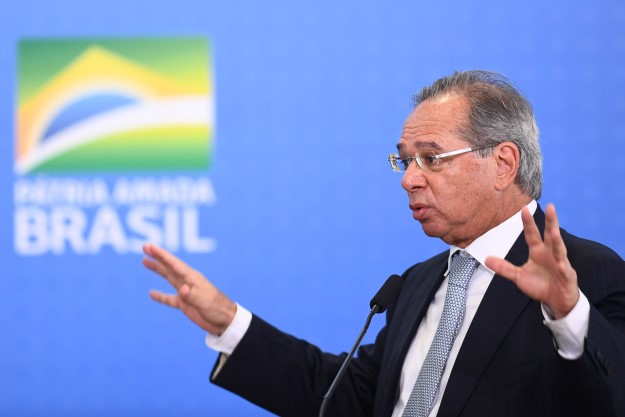Since Brazil’s new government took office, policymakers and investors have rightly focused on social security reform as a crucial ingredient for the country’s long-term solvency. Now that an ambitious reform package has passed the lower house, the government and Congress are looking to other areas, such as tax reform and reducing the oversized wage bill, to help boost growth.
But almost under the radar, the government has also continued a large divestiture program that started under the previous administration. President Jair Bolsonaro’s government has promised to deepen that effort by selling or shuttering as many state-owned enterprises (SOEs) as possible.
This program could help Brazil with some large fiscal challenges. Social security was the most important structural reform, and others remain that are crucial for sustained economic growth. But privatization can offer improvements in efficiency and reduce or eliminate the drain from loss-making SOEs. Moreover, privatization revenue would help finance a transition to fiscal sustainability by reducing government debt issuance to cover deficits.
Brazil’s federal assets set for immediate sale fall into four main categories:
1. Companies with a direct government stake, such as Eletrobras (where only IPO rights worth around $15 billion would be included) and some smaller companies.
2. Listed equity shares in private companies held by development bank BNDES and the treasury (totaling $28 billion as of February 2019; BNDES has already sold $8.5 billion this year), not counting BNDES investments in closely held companies, debentures, or funds.
3. Contingent stakes in presalt excess oil transfer rights ($21.7 billion, discounted for indemnification of Petrobras and 30% transfer to regional governments).
4. Concessions such as airports, ports, railroads, and toll roads, with an estimated value $8.4 billion (with $1.5 billion sold in 2019 so far).
In March 2019, I estimated conservatively that the privatization program could generate $89 billion in revenue through the end of 2020 (considering only the sale of liquid assets that affect the federal government’s balance sheet). My total estimate now comes to around $74 billion. The decline stems mainly from an agreement between the government and Congress that would transfer 30% of net oil and gas proceeds to regional governments — which, in any case, will help state and municipal governments with their current fiscal travails.
A total of $74 billion, however, pales in comparison to the roughly $164 billion in total assets. A full divestiture, if pursued, would take many years. Needless to say, the sale of the largest company, Petrobras, is not on the table. Hence, the dimension of Brazil’s current privatization program is similar in absolute terms to that of the 1990s, which came to roughly $83 billion, but smaller relative to the current size of the economy. If we add in sales planned by regional governments, however, asset sales over the next few years could be much larger.
Former President Fernando Henrique Cardoso’s 1990s privatization program was extremely ambitious, reducing the number of SOEs from 145 in January 1995 to 106 in December 2001. However, Workers’ Party administrations between 2002-2016 significantly increased that number to 154. The Bolsonaro administration is pursuing privatization, though the push did not start with his election. The government of former President Michel Temer had already started a divestiture program, reducing the number of SOEs to 134, and leaving a schedule of concession and other asset sales that continues in 2019.
The Bolsonaro administration recently announced its next planned sales. While Brazil’s largest SOEs are Petrobras, Eletrobras, BNDES, Banco do Brasil, and Caixa Econômica Federal, only Eletrobras is on the table for sale. Petrobras continues to sell assets – around $35 billion since 2015 – to reduce debt, but there has so far been no transfer to the federal government and privatization is still a long way off.
Divestiture differs greatly across each category of assets: The first batch includes Eletrobras IPO and signing bonus revenue, Casa da Moeda (the mint), Alcântara Space (a launchpad for space rockets), Correios (the mail service), and Lotex (the lottery). Infraero (airport holding company) is not included, as it will simply cease to exist following the auctioning off of 12 airports that took place earlier this year. The rest should only come to market after 2020. These sales may not generate much net revenue, but should increase efficiency and reduce the drain on public accounts. In any case, most of these companies are not yet ready for auction and will take more than two years to sell.
At the beginning of 2019, the BNDES had around $28 billion in listed company equities on its books, but that total has fallen to around $18 billion after sales worth just under $9 billion. These sales are likely to continue. The other assets that the BNDES holds are not liquid, and like the directly held SOEs, should only come to market after 2020, if at all.
The $8.4 billion in infrastructure concessions for sale in 2019 and 2020, another legacy of the Temer administration, do not bring in much direct revenue but are important for their investment potential and efficiency gains, laying the groundwork for future auctions.
If this privatization program is successful, it will allow real interest rates to fall. The main risk is that the larger the privatization effort, the greater the possibility that Congress would leave other reforms aside, as occurred in the late 1990s. However, Brazil’s prospects seem much better than the current pessimism, especially in light of progress on reforms and asset sales.
—
Welch is an economist specializing in Latin America with a Ph.D. from the University of Illinois Urbana-Champaign








